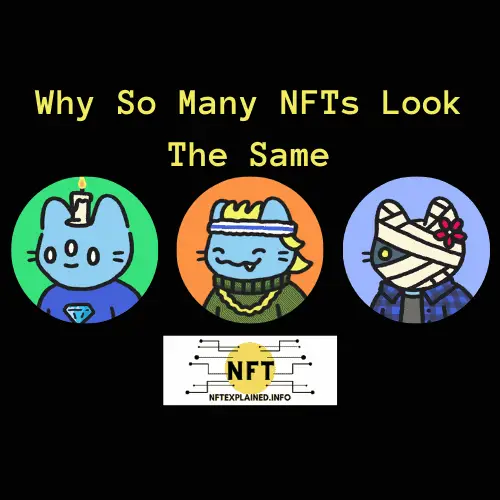
NFTs – non-fungible tokens – are unique one-of-one digital assets. NFTexplained.info is a team of long-term crypto investors who are well versed in the crypto and NFT space. In this article we will explain why NFTs from a collection appear the same.
Collection-based NFTs often appear ‘the same’ as they are based on a consistent design; however, they are different because each one often has randomly generated properties. These properties typically distinguish the NFT – impacting rarity and appearance – while still allowing people to tell which collection they are from.
Collection-based NFTs, like Cool Cats, are all based on a consistent design – which is the blue cat – while still having different features (making each one distinguishable and unique).
Features, i.e. a gold trait, can make the NFT from a collection more valuable due to aesthetics and even afford additional ownership benefits (i.e. access to more tokens from the NFT collection when staked).
Before an NFT has officially been revealed, you may be wondering why your NFT appears ‘the same’ as everyone else’s in a collection; this is because the metadata is not visibly revealed. NFTexplained.info has a full article explaining that phenomenon which we will link here.
Large collections, such as a collection of 10,000 NFTs, often have a fundamental underlying design theme – like a dog from the collection Top Dog Beach Club. The features of each dog, like the eyes, are all hand drawn but algorithmically generated (when put together) in order to make each one completely random in appearance and rarity.
How Are NFTs Different?
Each NFT is different; they are non-fungible since they can’t be easily exchanged. NFTs from collections are different due to the properties they have. Even NFTs that appear the exact same are not as there can be different, numbered copies of the same artwork.
NFTs can’t be exchanged in the same way that one US dollar is the same as any other US dollar. In everyday life, the dog you own is not the same as the dog your friend owns, even though they are both dogs.
NFTs allow you to prove you own a digital item; this is done via the blockchain.
Some NFTs can easily be distinguished, even when they are in the same collection, since they have different properties or traits (e.g. eyes, hats, glasses, background color, etc.)
Even if the NFT appears the exact same, it is still different due to the number ID. This can be thought of in the same sense that there may be 100 Lebron James trading cards but each one is different as they are numbered 1 – 100 (regardless of the fact that the picture on the card is the same).
How Can You Tell If An NFT Is Fake?
NFTs are verifiable assets; this means, it is possible to look at the creator of the NFT using blockchain based explorers like Etherscan. If the NFT is attempting to impersonate that of a famous collection, examining who created the NFT is a good solution. NFT marketplaces also verify collections.
Since NFTs are on the blockchain every transaction is recorded on a public, immutable ledger. This makes it easy to see previous owners of an NFT and this feature is known as provenance.
OpenSea typically verifies large NFT projects (i.e. SupDucks); however if a collection is not yet verified, looking at the volume traded and the number of owners can be a good indicator.

The creator of the large NFT project is often verified by OpenSea as well.
Why Do Some NFT Look So Bad?
While appearances are very subjective, some NFT collections may appear to “look bad” because little work has been done in designing the NFT(s). Despite looks, NFTs often sell for high prices due to other factors aside from artwork like utility and supply/demand economics.
Hastily put together collection of NFTs can be a sign of someone looking to make money via a rug pull; this is where the founders – who will typically be anonymous – abandon the project after mint. NFTexplained.info has a full article covering this topic and factors to look out for to spot this scam. That article can be found here.
Blue chip NFT collections like Bored Ape Yacht Club command extremely high prices, not because of the appearance of the art, but because of the utility received from owning one. This utility includes airdrops (eg. mutant serum and Bored Ape Kennel Club), community, and access to real world events.
The NFT market works using supply and demand economics and we have a full article covering that aspect of the NFT market overall; we will link that here.
We hope you are just as excited as we are about NFTs and continue to stay informed at NFTexplained.info. To get the latest news in this rapidly evolving space, follow our team on Instagram & Twitter!
